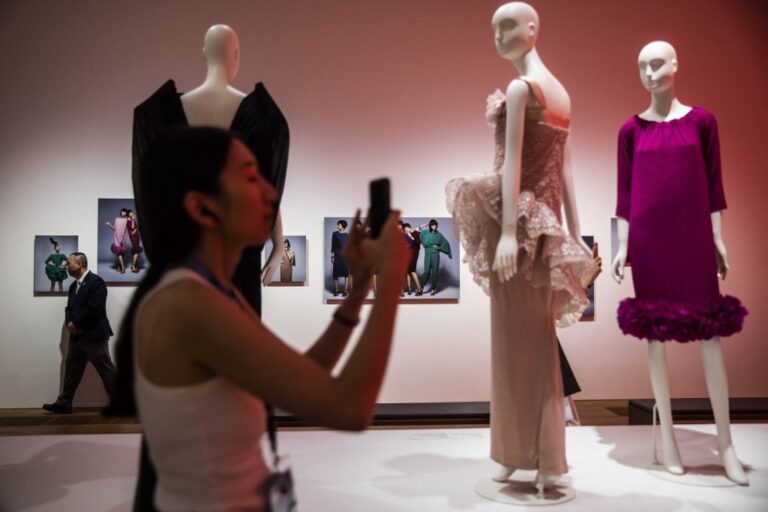
Erin Cho, Dean and Limin Professor in Integrated Strategies and Leadership in Fashion, and Wang Xungai, Chair Professor of Fiber Science and Technology (Global STEM Professorship Scheme) of the School of Fashion and Textiles at The Hong Kong Polytechnic University
Fashion touches everyone. It has always been a sector that embraces and reflects the latest technology and society’s agenda. Much like the Industrial Revolution, the fashion and textiles industries have been undergoing an unprecedented transformation propelled by emerging technologies in recent years.
Today, researchers, designers, and industry leaders are embarking on ventures into unconventional sources for fibres and innovative ways of recycling and managing waste, harnessing Artificial Intelligence (AI)-powered design tools for unlocking creativity and advanced production methods, and applying the latest digital technology for distribution and promotion, all fueled by critical and urgent issues affecting our planet, society and humanity. As educators and forward-thinkers in the industry, it is crucial to take note of the seismic shifts and noteworthy areas of progress that are shaping the future of fashion in order to future-proof our leaders of tomorrow.

The world’s first “sweatable” textile fabric, Sweatextile, was created with the use of digital technologies. Source: School of Fashion and Textiles at The Hong Kong Polytechnic University.
Innovating textiles: From alternative fibres to artificial intelligence
A great degree of the materials that support our lifestyle starts with a strand of fibre. Clothing is one example, but fibres and textiles are also critical for many interior home goods, cars, construction materials for buildings, and any industries utilising soft or composite materials to make things more sustainable, stronger, and lighter. In particular, researchers are exploring alternative fibres from unconventional sources as the fashion industry transitions to sustainable sourcing (SS) to address the environmental problems faced by societies worldwide.
Recent innovative research includes natural fibres that can be extracted from rocks and pineapple leaves, and biodegradable fibres that have the potential to outperform synthetics in terms of strength, moisture and odour management, and comfort. Other exciting innovations in this area include the world’s first “sweatable” textile fabric, Sweatextile, which features spatially distributed channels that imitate sweat glands, enabling rapid, one-way liquid flow while repelling external liquid contaminants. At fashion schools that place emphasis on textiles, students are exposed to these innovative advancements and taught to incorporate them into designing future fashion pieces. This equips individuals with the resilience and comfort necessary to navigate the challenges of our ever-changing world.
At the same time, the power of AI and digital technology has ignited the immense possibility of textiles, allowing dynamic interactions between wearer and garment. Our research team has developed a colour-changing textile embedded with a tiny camera and leveraging AI. This fabric possesses the remarkable ability to change colour by detecting simple gestures, such as a thumbs-up or OK sign. Alternatively, it can be controlled through a mobile app that allows for complete customisation. This recyclable smart textile is aimed at addressing the issue of textile waste by reducing the need to purchase multiple items in different colours.
Changing lives: For students, designers, and patients alike
Generative AI-powered tools have likewise become instrumental in enhancing productivity and streamlining the creative process. By simply uploading sketches, materials, and colour palettes, designers can leverage AI-assisted tagging features to automate laborious tasks that used to take days, reducing them to mere hours or even generating a dozen design templates within seconds.
This accelerated workflow enables designers to focus their time and energy on augmenting and refining these templates to perfection. Incorporating the latest technological advancements into the teaching syllabus is of paramount importance. It empowers students to develop an open-minded approach and explore the myriad applications of AI in transforming and enhancing the fashion production chain, thereby redefining the creative elements in fashion design.
On the other hand, the combination of Generative AI and fashion holds great promise for transforming the lives of those struggling with complicated medical conditions. One of our research teams has made significant advances in the treatment of Adolescent Idiopathic Scoliosis (AIS), which is the most common type of scoliosis affecting approximately two to three percent of adolescents. They have successfully utilised Generative AI to develop a series of tailor-made functional clothing specifically designed for AIS patients, contributing to a social good aspect through the integration of AI and fashion.

A recent cultural project done by the school employed digital technologies, wearable tech and 3D printing to create modern yet traditional Cantonese opera costumes. Source: School of Fashion and Textiles at The Hong Kong Polytechnic University.
Preserving our cultural heritage: The power of 3D printing and other digital technologies
Today’s advanced 3D printing machines are also revolutionising the high-end fashion industry by enabling many different materials to be printed directly onto fabric at the same time, in full colour, with transparency and intricate textures. This new technology allows students and designers to create custom fabrics and prints with elaborate designs and delicate details previously unattainable through traditional manufacturing methods.
A recent cultural project of ours employed digital technology, wearable tech and 3D printing to create modern yet traditional Cantonese opera costumes. The project focused on the impact of innovative textile materials and structures on the physical movements of the opera performers. By combining versatile pleated textures and digital virtual algorithms that considered the trajectory of human body movements, designers were able to create garments that were soft, pliable and conformed to the body, enhancing the freedom and emotional expressiveness of actors wearing them and aiming to inspire both performers and the audience with greater creativity.
By leveraging 3D printing, the modern design elements infused with traditional aesthetics not only preserved the cultural heritage of Cantonese opera but also brought a fresh and innovative perspective to the art form. This integration of technology and traditional craftsmanship demonstrates how advancements in production can be harnessed to revitalise and enrich cultural traditions, ensuring their relevance and appeal to contemporary audiences.
Education plays a vital role in preparing students for the future and making a positive impact on society within their respective fields. In today’s digital era, it is imperative for education to evolve and adapt to the ongoing technological revolution. From the perspective of fashion academia, it is crucial for the next generations to stay informed about technological advancements to reimagine fashion and textiles as it holds tremendous promise for a tomorrow where fashion seamlessly combines innovation, sustainability and creativity to take humanity to the next level.
*The views expressed are those of the author and do not reflect the official policy or position of Study International.










